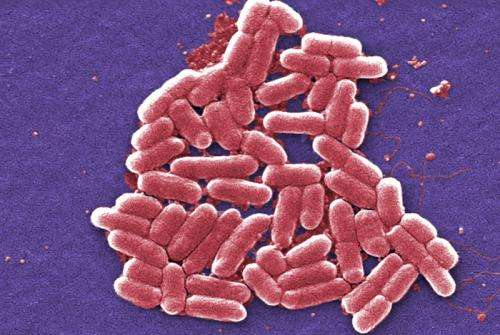Live pathogens: Rapid detection technique developed

(Phys.org)—Los Alamos researchers have developed a better technique for quick detection of live pathogens in the field. Identification of viable bacteria in a complex environment is scientifically challenging. Current detection and diagnostic techniques are inadequate in major public health emergencies, such as outbreaks of food-borne illness. Detection of live pathogens in the suspected food supply requires days of laboratory culture.
LANL's new method eliminates the need for laboratory culture and greatly speeds the process. The technique relies on bacteria being critically dependent upon the key nutrient iron. The bacteria synthesize and release sequestering agents, called siderophores, into their environment to bind iron tightly for subsequent uptake. This process occurs only in live, intact bacteria. The LANL team created a simple method to use bacterial siderophores for selective, rapid identification of viable bacteria in their surroundings.
Research achievements
Bacteria secrete siderophores to sequester and incorporate the iron they need. The scientists used bacterial siderophores to identify bacteria selectively and rapidly in complex matrices and to discriminate viable bacteria from their dead counterparts.
The team developed surface chemistry strategies to tether siderophores to glass slides. Surface functionalization chemistry, which was developed at LANL for self-assembled monolayers, tethers siderophores and minimizes non-specific interactions associated with complex biological samples, such as culture filtrate, serum and urine. The tethered siderophores captured viable bacteria from a mixture of viable and dead Escherichia coli. The team also used a software analysis tool that was originally developed for satellite imaging to conduct quantitative measurement of fluorescence staining in biological specimens. This tool enables accurate and fast quantitation of the data.
Significance of the research
Rapid and selective determination of bacterial viability is critical for food safety. This simple analytical technique has applications for other situations, such as the rapid determination of the efficiency of a decontamination process, efficacy assessment after initial medical intervention to infection, and detection of exposure to a biological threat agent. The siderophore approach could be universally applicable to all bacteria, making it extremely useful for detection in complex backgrounds.
The journal Advances in Biological Chemistry published the research.
Provided by Los Alamos National Laboratory


















